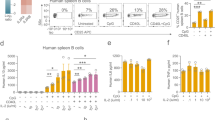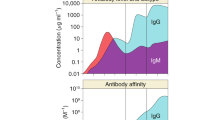Abstract
WITH respect to maturation stage, function, and cell surface constituents, lymphocytes bearing immunglobulin on their (B cells) comprise a heterogenous population. It has been suggested1 that binding of mitogens to membrane surface surface constituents triggers the events leading to stimulation of cell mitosis. The various B cell mitogens can be divided into different chemical classes and different types of mitogens presumably react with different membrane surface constituents. According to these assumptions we tested whether various B cell mitogens act on the same or on different subpopulations of B cells.
This is a preview of subscription content, access via your institution
Access options
Subscribe to this journal
Receive 51 print issues and online access
$199.00 per year
only $3.90 per issue
Buy this article
- Purchase on Springer Link
- Instant access to full article PDF
Prices may be subject to local taxes which are calculated during checkout
Similar content being viewed by others
References
Melchers, F., and Andersson, J., Transplant Rev., 14, 76 (1973).
Diamantstein, T., Wagner, B., L'age-Stehr, J., Beyse, I., Odenwald, M. V., and Schulz, G., Eur. J. Immun., 1, 302 (1971).
Diamantstein, T., Vogt, W., Rühl, H., and Bochert, G., Eur. J. Immun., 3, 488 (1973).
Rühl, H., Vogt, W., Bochert, G., and Dimantstein, T., Immun. (in the press).
Author information
Authors and Affiliations
Rights and permissions
About this article
Cite this article
DIAMANTSTEIN, T., BLITSTEIN-WILLINGER, E. & SCHULZ, G. Polyanions and lipopolysaccharide acts on different subpopulations of B cells. Nature 250, 596–597 (1974). https://doi.org/10.1038/250596a0
Received:
Published:
Issue Date:
DOI: https://doi.org/10.1038/250596a0
This article is cited by
Comments
By submitting a comment you agree to abide by our Terms and Community Guidelines. If you find something abusive or that does not comply with our terms or guidelines please flag it as inappropriate.



